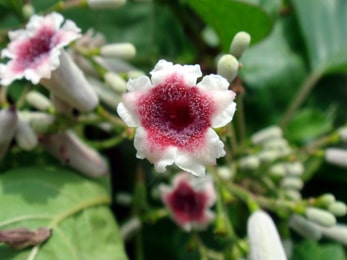
What is Paederia Foetida?
Paederia foetida also Know as skunkvine, stinkvine, or Chinese fever vine. it is a fast growing herb, slender, and perennial. It is a climbing plant producing the stems which is 1.5 – 7 meters long that takes the support of other plant to grow.
Paederia foetida is an important herb that grows in central and eastern Himalayan ranges. It has been used in Ayurvedic medicines which has been used since ages for different purposes. As per the properties and functions of the herb it is used in healing the problems related to intestinal health (particularly anti-diarrheal and anti-dysentery) and as a support for male health. As the herb is known as “Gandha Prasirini” means spreading the smell because the herb has foetid smell when rubbed. As per the property of the herb its effect on tridoshas by decreasing Kapha and Vata doshas and make the working of the body in a proper and healthy way.
- Botanical Name – Paederia foetida
- Sanskrit Name – Gandha Prasirini
- Hindi Name – Gandha prasarani or Pasaran
- Telgu Name – Takkeda, Savirel
- Bengali Name – Gandhabhaduliya, Gandhabhadule
- Marathi Name – Hiran – vel
- Gujrati Name – Gandhana
- Tamil Name – Pinarisangai
- Assamese Name – Bhedai lota or Paduri lota
- Other Name – Daun Kentut, Kasembukan, Kantutai
- Family Name – Rubiaceae
Classification
- Kingdom – Plantae
- Subkingdom – Tracheobionta – Vascular plants
- Superdivision – Spermatophyta – Seed plants
- Division – Magnoliophyta – Flowering plants
- Class – Magnoliopsida – Dicotyledons
- Subclass – Asteridae
- Order – Rubiales
- Genus – Paederia L. – Sewer vine
- Species – Paederia foetida L. – Stinkvine
Cultivation of the Paederia foetida herb
Skunk Vine herb is found in a range of environments from the warm pleasant zone to the tropics. It easily grows in any fertile soil so long as it is well drained.
The shrunk vine herb climbs over shrubs and trees to take their support, weighing them down and hampering their regeneration. They also occupy pastureland and are troublesome along roads and on power lines. The seeds of this herb may be dispersed by birds and the plant is also spread by the transport of rooted fragments.
This plant can be found flowering and fruiting throughout the year in tropical and subtropical conditions; in other localities, it flowers during the rainy season, and fruits early in the dry season.
The flowers of this plant are short-lived, open early in the morning and fall off after 2 days; entire inflorescences, however, bear flowers for a long period of time. The plants are available in large quantity as a weed in west Bengal, Kerala, Tamilnadu, Gujarat, Karnataka and Assam.
Medical Qualities of Paederia foetida
- Rasa (taste) – Tikta (Bitter)
- Guna (qualities) – Guru (Heavy), Sara
- Vipaka (taste conversion after digestion) – Katu (Pungent)
- Virya – (potency) – Ushna (Hot)
Skunk Vine Uses
- Rheumatism
- Infertility
- Paralysis
- Abdominal pain
- Arthritis
- Abscesses
- Colic
- Gout
- Stimulate nervous system
- Diarrhea
- Dysentery
Skunk Vine Benefits
- Skunk Vine leaves are useful for rheumatism pain.
- It is used to treat infertility and paralysis.
- The decoction is useful for abdominal pain, abscesses, arthritis, overeating etc. It should be taken one to two teaspoonful twice a day.
- The root is beneficial for emetic, emollient and carminative, useful in colic, contraction, rheumatism and gout.
- It stimulate the central nervous system.
- The leaves are anti-inflammatory and hence reduce the inflammation in the body.
- Whole plant is useful for diarrhea and dysentery patients.
- The boiled and mashed leaves are applied to the abdomen for urinary retention.
- Powder of skunk vine leaves are applied to the abdomen for flatulence.
- The fruit used for toothaches.
- Decoction – soaked cloth is applied to the forehead for fever.
It appears to have typical anti-oxidant and anti-inflammatory effects that are common to most herbs, with no evidence to suspect that either of those mechanisms is remarkable.
Remedial Benefits of Skunk Vine
Abdominal Pain and flatus – Leaf juice is used
As the leaves have foul smell so the recipe should be made with full caution under proper administration. Paste of the leaf is made and squeezed to get the fresh juice.
It is given in the dose of 2-3 ml preferably empty stomach. The use of it gives relief from abdominal pain, flatus, recurrent complaints of the worm infestation and etc.
Arthritis and inflammatory condition – Whole plant is useful
The fine paste of the leaves is made and even tamarind leaves are also mixed in it as per the requirement. The mixture made from both the leaves is applied on the joints which are effected by arthritis and swelling. This herbal paste is very effective and pacifies the pain and swelling.
Joint pain and body ache – Decoction of the herb
The herbal decoction made with the combination of Gandha Prasirini herb (Paederia foetida), Shunthi (Zingiber officinale), and Jeeraka (Cuminum cyminum) in equal quantity. The dose of it has to 20- 30 ml and is very effective. Also beneficial for joints pain and body ache.
Vatic complaints, especially in neuralgia and muscular pains – In form of oil of whole plant
Oil is made by crushing the whole plant in a paste form and the quantity has to be 1 part and the decoction- 1tablespoon of powder is added with 2 cups of water, boiled and reduced to 1 cup and filter it and 16 part by quantity. Sesame oil in 4 parts. All the ingredients are mixed and cooked till the complete evaporation of the moisture.
This has to be used externally for neuralgia and muscular pain, and joint pain and gives relief from it.
Parts used
Whole plant
Dose
- Powder – 3 to 6 gm
- Decoction – 20-30 ml
- Leaf juice – 2-3 ml
